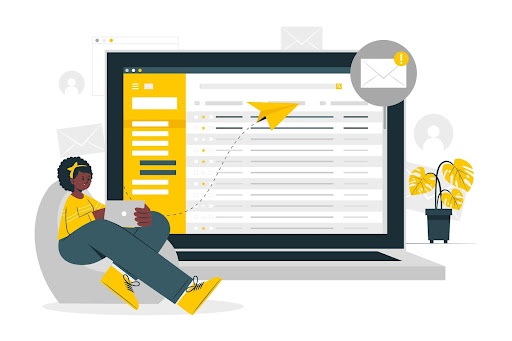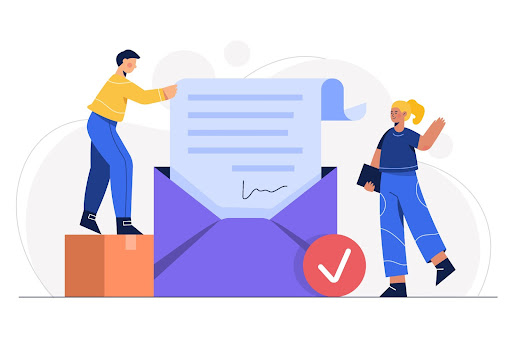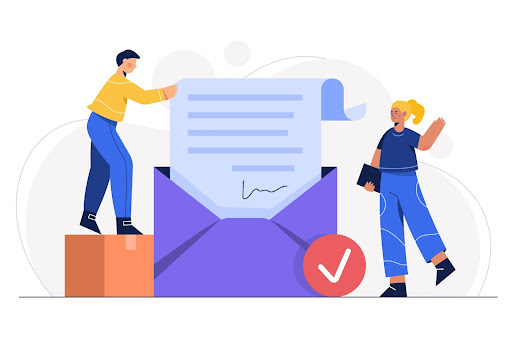
Writing an email is essential for conveying your message clearly, capturing the recipient's attention, and achieving your desired outcome. Whether you're sending a business proposal, following up on a job application, or simply reaching out to a colleague, mastering the art of effective email writing is crucial. This article will provide you with valuable insights and practical tips to help you write emails that are compelling, persuasive, and impactful.

Email communication plays a vital role in the business world for several reasons:
Professional emails have the potential to reach a wide audience and leave a lasting impact:
Whether you are reaching out to a potential client, collaborating with colleagues, or following up on an important project, here is how write an email for business purposes.
The email subject line is the first impression that recipients have of your message. A clear and concise subject line is crucial for grabbing attention and encouraging recipients to open your email. It should accurately summarize the purpose or main idea of the email, giving recipients a preview of what to expect. Avoid vague or generic subject lines that might get overlooked or mistaken for spam. Instead, be specific and use keywords that are relevant to the email content.
To ensure your email stands out and captures attention:
Example:

Proper email formatting is essential for ensuring that your email is visually appealing, easy to read, and professional. Consider the following tips for the right email format:
The tone and language you use in your email play a crucial role in conveying your message effectively and maintaining a professional image. Consider the following guidelines:
A call to action (CTA) is a vital element of an effective business email. It guides recipients on what actions they need to take after reading your email. Here are some tips for creating an effective CTA:
Example:
I kindly request that you review the attached proposal and provide your feedback by [date]. Your insights and input are crucial to finalizing this project and ensuring its success. Please feel free to contact me via email or phone at your earliest convenience. Thank you in advance for your prompt attention to this matter.
To take your email writing skills to the next level, consider incorporating these tips.
Personalization is a powerful tool for building relationships and engaging your recipients. Beyond simply addressing the recipient by their name, take the time to understand their specific needs, challenges, or interests. Tailor your email to resonate with them on a personal level. Refer to previous interactions or discussions you have had, and incorporate relevant details to show that you value the individual relationship. Personalization demonstrates that you have taken the time and effort to understand the recipient, leading to increased engagement and a higher likelihood of a positive response.
Storytelling is a compelling way to communicate your message and make it more memorable. Advanced email writing involves strategically incorporating storytelling techniques to capture the recipient's attention and evoke an emotional response. Begin with a captivating opening that sets the stage for your story. Introduce the conflict or challenge, describe the steps taken to overcome it, and highlight the positive outcomes achieved. By structuring your email as a story, you create a narrative that engages the recipient and makes your message more impactful and relatable.
Social proof is a powerful psychological phenomenon that influences people's behavior. It involves showcasing evidence of others' positive experiences, such as testimonials, case studies, or success stories. By incorporating social proof into your email, you build credibility and trust with your recipients. Include relevant testimonials or success stories that demonstrate how your product, service, or solution has benefited others. This not only validates your claims but also gives the recipient confidence in your offerings.
To differentiate yourself from competitors and establish yourself as a thought leader, provide unique insights or expertise in your emails. Share industry trends, market analysis, or exclusive research findings that are relevant to your recipient's interests or challenges. Offering valuable information that they can't easily find elsewhere positions you as a valuable resource and builds trust. This approach also encourages recipients to view your emails as valuable resources rather than mere sales pitches, increasing their engagement and receptiveness to your message.
The choice of words in your email can significantly impact its effectiveness. Advanced email writing involves using powerful words and persuasive language to influence the recipient's response. Choose words that evoke emotions, create a sense of urgency, or emphasize the benefits they will gain. For example, instead of saying «interested», use «excited» or «enthusiastic». Instead of «limited time offer», use «exclusive opportunity». Incorporating persuasive language that resonates with the recipient's desires or pain points increases the likelihood of them taking the desired action.
While advanced techniques can add depth and creativity to your email, it is essential to maintain clarity and simplicity in your message. Use clear and concise language, avoiding jargon or technical terms that may confuse the recipient. Break down complex ideas into digestible chunks to ensure your message is easily understood. Clarity and simplicity enhance the readability and impact of your email.
Follow-up emails are a crucial part of professional communication. However, writing an effective follow-up email requires mastering the art of timing and content. Let's explore the technique of writing follow-up emails that grab attention, maintain professionalism, and yield the desired outcomes.
The timing of your follow-up email plays a vital role in its effectiveness. Too early, and you risk coming across as pushy or impatient. Too late, and your email might get lost among other messages or become irrelevant. Here are some guidelines for timing your follow-up emails effectively:
In addition to timing, the content of your follow-up email is crucial for engaging the recipient and achieving the desired outcome. Here are some tips for creating compelling content:
Example:
Dear Ms. Johnson,
I hope this email finds you well. I wanted to follow up on the project proposal I sent last week. I understand that you may be busy, but I wanted to kindly request your feedback or any additional information you may require. The deadline for submission is approaching on [date], and your input is crucial to moving forward.
If you have any questions or need further clarification, please don't hesitate to reach out to me. I appreciate your attention to this matter and look forward to hearing from you soon.
Best regards,
John Doe

When writing emails, it is crucial to be aware of and respect cultural differences to ensure effective communication and avoid misunderstandings. Understanding the nuances of different cultures can help foster better relationships, build trust, and achieve successful outcomes. Here are some tips for navigating cross-cultural communication.
Cultural norms vary greatly around the world, influencing communication styles, etiquette, and expectations. When writing emails to individuals from different cultures, take the time to research and understand their cultural norms. For example, some cultures value formal and indirect language, while others prefer a more casual and direct approach. By adapting your communication style to align with cultural norms, you demonstrate respect and avoid potential misunderstandings.
Language and tone play a significant role in cross-cultural communication. Use simple and straightforward language to ensure clarity, especially when there may be language barriers. Avoid idioms, slang, or humor that may not translate well across cultures. Additionally, be conscious of the tone you convey in your emails. Some cultures value politeness and formality, while others may prioritize directness. Strive to strike a balance that aligns with the cultural preferences of your recipients.
In many cultures, hierarchy, and titles hold great importance. When addressing individuals from cultures that prioritize hierarchy, it is crucial to use appropriate titles and honorifics. For example, in some cultures, it is customary to address individuals by their last name or use formal titles such as «Mr.», «Ms.», or «Dr.». Failure to do so may be seen as disrespectful or unprofessional. Research the cultural norms regarding hierarchy and titles to ensure you address recipients appropriately.
Cultural sensitivity requires avoiding stereotypes and generalizations. Every individual is unique, and cultural norms can vary within culture itself. Avoid making assumptions based on stereotypes or generalizations. Treat each individual as an individual, rather than making assumptions based on their cultural background. Be open-minded, curious, and willing to learn about different perspectives and practices.
In some cultures, visual communication tools can enhance understanding and make emails more effective. Consider incorporating visual aids, such as charts, graphs, or images, to support your message. Visual representations can transcend language barriers and provide clarity and context to your communication.
Misinterpretations can occur even with the best intentions. If you are unsure about the meaning or intention of an email received from someone from a different culture, seek clarification. Instead of making assumptions, ask questions to ensure mutual understanding. Similarly, provide opportunities for recipients to seek clarification if they have any doubts or questions about your emails. Encourage open dialogue and promote a culture of understanding.
By understanding and respecting cultural differences when writing emails, you can bridge cultural gaps, foster positive relationships, and enhance communication effectiveness. Embrace cultural diversity and approach cross-cultural communication with curiosity, empathy, and a willingness to learn. With awareness and adaptability, you can navigate cross-cultural communication challenges and achieve successful outcomes in your email exchanges.

Email is an integral part of business communication, and with the increasing volume of messages, it's essential to leverage technology to manage and send emails more efficiently. By utilizing the right tools and software, businesses can streamline their email communication process, save time, and improve overall efficiency.
Here is how you can use it:
Modern tools for mass email campaigns make it possible to automate and simplify your work, as well as provide you with a large amount of data that you can use to analyze and evaluate your results. When choosing a mass email sender, pay attention to whether it meets your needs. For example, Atompark's tools don't require monthly subscription renewal and are perfectly combined with each other.
Writing an effective email is a valuable skill that can greatly impact your personal and professional relationships. By following the key elements discussed in this article, such as using clear subject lines, proper formatting, appropriate tone, and incorporating effective calls to action, you can improve the quality and impact of your email communication. By understanding the key elements and implementing best practices, you can create emails that leave a lasting impact on recipients. Remember, continuous learning, adaptation, and incorporating technology tools can help you refine your email writing skills and achieve greater success in your professional endeavors. So, start implementing these tips and watch your email communication soar to new heights.
Effortlessly Manage and Send Bulk Emails with Atomic Mail Sender.
Try It For Free!


Subscribe to us and you will know about our latest updates and events as just they will be presented





